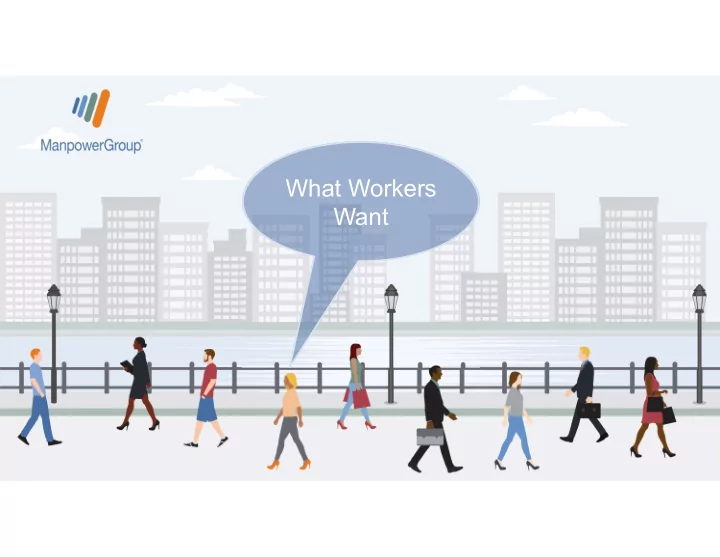

What Workers Want
Pre-COVID-19
Workforce Trends We are in the midst of a Skills Revolution where technology is transforming organizations and skills needs are changing rapidly, accelerating a global talent shortage and threatening productivity, sustainability and growth. By 2022, 54% of all employees will require While 38% of organizations significant re- and upskilling. Of these, about say it is difficult to train “54% of employers 35% are expected to require additional training in-demand technical skills, say they can’t find the of up to six months , 9% will require reskilling 43% said it is even harder skills they need. lasting six to 12 months, while 10% will require to teach the soft skills. 2019 Talent Shortage Survey additional skills training of more than a year. 2019 Humans Wanted: WEF: 2018 Future of Jobs Report Robots Need You Report HR People + Strategy ● September 2020 3
Global Talent Shortages at a 13-Year High Global Talent Shortages (2006 – 2019) HR People + Strategy ● September 2020 4 *Data collected in Q4 2017
Large Companies Face Almost Double the Difficulty Difficulty Filling Roles by Company Size HR People + Strategy ● September 2020 5
Top 10 Most In-Demand Roles HR People + Strategy ● September 2020 6
What Workers Want: A Generational Perspective What Workers Want varies by age, gender and geography. More Pay, Flexibility and Challenging Work are non-negotiables to all. Other priorities depend on where people are in their career life cycle and work as additional levers that employers can pull to attract and retain in-demand talent and under-represented groups. For example: Millennials Gen Z Gen Xers Baby Boomers Know they have career Ambitious, hungry for cash Know that flexibility = wellbeing Prioritize challenging work in ultramarathons ahead of them and career development their top needs HR People + Strategy ● September 2020 7
Hierarchy of Needs Top Worker Needs 1. Pay always matters Pay is the top attraction and retention factor for all workers under 65 years old, regardless of gender. 2. Personalized career insight, driven from data and assessment 81% of workers who have been assessed report higher job satisfaction. 3. Challenging work in the form of education, experience and exposure People want challenging work, to develop skills and further careers. Challenge ranks among the top 5 priorities for workers of all ages, genders and geographies. 4. Flexibility and control over calendar is a must and contributes to worker wellbeing Flexibility ranks in the top 3 priorities for workers of all ages, genders and geographies, it's the 2nd most important attraction factor for workers aged 25-44. 5. Purpose is a must - workers want to take pride in what they do and who they work for Purpose, brand and reputation rank in top 10 attraction factors for all workers. HR People + Strategy ● September 2020 8
Post-COVID-19
Work Reimagined Choice & Voice
What we are learning Technology is Many employees can work from key to wherever work and life Well-being is key Employees are Physical distancing will curious & are need to continue reskilling Leadership is being Finding redefined talent is still difficult but different HR People + Strategy ● September 2020
COVID-19: Global Impact At Work • Almost all workers (94%) report concerns about going back to the workplace • Most people agree that work-life balance will be better going forward • Keeping their job is a top priority for workers in all countries and sectors (91%) with the exception of IT workers who value flexibility most After health concerns, workers 43% workers believe this Keeping their job are most worried about 8 in 10 want to better marks the end of the office is a top priority for returning to an old balance work and family 9-5. Most prefer 2-3 days workers everywhere way of working, losing the in the future a week in the workplace flexibility they have gained HR People + Strategy ● September 2020
In-Demand Roles Shifting HR People + Strategy ● September 2020
The Skills Revolution is Real HR People + Strategy ● September 2020
Celebrate or Commiserate – Returning to the Workplace When economic outlooks are uncertain,�employability�matters�most to workers, with�9 in 10 workers say simply keeping their job is most important. Yet�how workers feel about a return�varies�by gender and�career�stage:� Gen�Z�vs. Millennials: Gen�X�vs. Boomers: Gender Divide: Working Parents: Gen Z’s are most keen Gen X value being in the Almost half of men (46% feel positive Men with children�list spending�time with to return to the workplace workplace to concentrate and about returning, only one-third of women (35%) their family as a top�benefit to working to develop their careers collaborate away from feel the same. Women report feeling more remotely. Women�feel�more�negatively and socialize, (51%), household responsibilities concerned or nervous about the return. Both men about going back to work,�increasing in while millennials are and women rank not having to commute and concern the younger the child – 61% for children 0- least positive (38%) having flexibility to work when convenient 5, 53% for children 6-17 and 50% for 18+. in their top three benefits of working from home HR People + Strategy ● September 2020
5 Ways to Make the Next Normal Better for All Employers needing�to�adopt a People First approach and�to reimagine a future of work that works for�organizations�and individuals alike�-�prioritizing�health, wellbeing,�and caring responsibilities. 01 02 03 04 05 Physical and Skills are Evolving Flexibility and Build Resilience – Ask Why. Emotional – Prepare for Balance for the In People and the Why Return Wellbeing = New that Reality Many not the few Organization Health and Safety About the Research:� ManpowerGroup commissioned research to�survey�8000�workers on their�attitudes towards�work since the impact of COVID-19.��Research was carried out�in�June 2020 by� Reputation Leaders �surveying�workers aged 18 and over,�balanced by age, gender in 8 countries, France, Germany, Italy, Mexico, Singapore, Spain, UK and US.� HR People + Strategy ● September 2020
Thank You
Recommend
More recommend